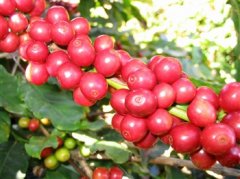The harvesting and processing methods of coffee beans basic knowledge of coffee

From the coffee-producing countries, we can find that since almost all coffee is produced in countries with more cheap labor, it can be guessed that the process of harvesting coffee beans requires a lot of manpower. Yes, the harvest of coffee is very hard, and it takes a lot of manpower, especially in many high-quality and high-quality coffee, you can only pick the fully ripe red cherry-like fruits of coffee trees in order to make high-quality coffee, and because of this, because the coffee cherries of all coffee trees do not mature at the same time, it also requires some people to return to the same tree to pick coffee cherries.
Picked coffee cherries also need to be processed. Generally speaking, the processing of raw coffee beans can be divided into two ways, one is washing, the other is drying. As the name implies, washing is a way of screening by washing. First, the pulp of the harvested coffee fruit is removed, and the pulp-removed coffee fruit is soaked in a tank full of water and treated by fermentation. The fermented coffee beans are poured out, washed with clean water, then removed, dried in the sun or dried in a machine. Finally, a special sheller for coffee beans is used to remove the pulp and peel, that is, raw coffee beans.
Compared with the water washing method, the drying method is relatively simple. The coffee fruit after harvest is spread in the local exposure field for two weeks, and the coffee beans are swept several times a day with manual rakes, so that the coffee beans can be dried more evenly. When the fruit is dried, the coffee beans will be separated from the skin, and then use a sheller to remove the dried pulp and peel.
These two production methods have their own advantages and disadvantages, but both can produce high-quality coffee beans. generally speaking, the coffee beans produced by water washing have relatively distinct acidity and the same quality, and the acidity of dry coffee is lower than that of water washing coffee. The flavor is also more diversified.
Important Notice :
前街咖啡 FrontStreet Coffee has moved to new addredd:
FrontStreet Coffee Address: 315,Donghua East Road,GuangZhou
Tel:020 38364473
- Prev

Coffee common sense becomes the 10 essential factors of fine beans.
1. Must be at least 90% coffee containing bourbon, Pacamara or Maragogipe, 100% fully ripe to red wine color 3, separate from other coffee in the manufacturing process, avoid mixing other poor coffee to ensure its good quality 4, wash 5% fresh water, 100% sun 6, pick fruits by hand and wash 7, be sure
- Next

How to treat fresh coffee fruit into raw coffee beans?
The variety of coffee treated with raw beans certainly determines the natural flavor, but the treatment of raw beans determines the acquired quality. Selected coffee attaches great importance to flavor and quality, so it pays special attention to the technology and details of processing. Harvest: the harvest method is one of the criteria for judging selected coffee. if calculated from the time of germination, Arabica coffee will take about 5 years to blossom and bear fruit. Brazil
Related
- Beginners will see the "Coffee pull flower" guide!
- What is the difference between ice blog purified milk and ordinary milk coffee?
- Why is the Philippines the largest producer of crops in Liberia?
- For coffee extraction, should the fine powder be retained?
- How does extracted espresso fill pressed powder? How much strength does it take to press the powder?
- How to make jasmine cold extract coffee? Is the jasmine + latte good?
- Will this little toy really make the coffee taste better? How does Lily Drip affect coffee extraction?
- Will the action of slapping the filter cup also affect coffee extraction?
- What's the difference between powder-to-water ratio and powder-to-liquid ratio?
- What is the Ethiopian local species? What does it have to do with Heirloom native species?

